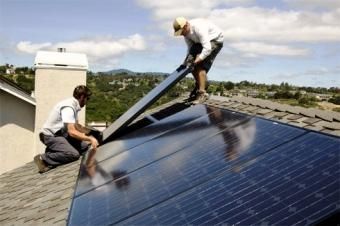Study: Vast CA solar power possible using existing infrastructure
by Chris Reed | March 24, 2015 7:53 am
 A new study[1] for Nature Climate Central journal says California could have abundant solar power to meet all of its needs — and without building huge fields of solar arrays like the Tonopah facility by Interstate 15 near the Nevada border.
A new study[1] for Nature Climate Central journal says California could have abundant solar power to meet all of its needs — and without building huge fields of solar arrays like the Tonopah facility by Interstate 15 near the Nevada border.
Research by UC Berkeley energy scholar Rebecca R. Hernandez and energy researchers Madison K. Hoffacker and Chris Field found that …
the amount of energy that could be generated from solar equipment constructed on and around existing infrastructure in California would exceed the state’s demand by up to five times. …
“Integrating solar facilities into the urban and suburban environment causes the least amount of land-cover change and the lowest environmental impact,” Hernandez explained.
Just over 8 percent of all of the terrestrial surfaces in California have been developed by humans — from cities and buildings to park spaces. Residential and commercial rooftops present plenty of opportunity for power generation through small- and utility-scale solar power installations. Other compatible opportunities are available in open urban spaces such as parks.
Likewise, there is opportunity for additional solar construction in undeveloped sites that are not ecologically sensitive or federally protected, such as degraded lands.
“Because of the value of locating solar power-generating operations near roads and existing transmission lines, our tool identifies potentially compatible sites that are not remote, showing that installations do not necessarily have to be located in deserts,” Hernandez said.
But the research paper doesn’t focus strongly on the costs involved. Even as they add renewable supplies, utilities continue to need inexpensive sources of power because of their obligations to shareholders and because of public pressure. Even as the cost of solar arrays comes down and their efficiency increases, natural gas has never been cheaper in inflation-adjusted dollars.
According to the California Public Utilities Commission, 35 percent or so of natural gas used in California in recent years has come from other states benefiting from the fracking-driven boom in energy exploration.
In 2050, state can’t “be burning much of anything”
At a January conference in Los Angeles, however, top state officials seemed of two minds[2] about California relying on natural gas:
California has been one of the nation’s bigger users of natural gas, employing it as a bridge fuel for some time as it moved away from coal and oil, said Robert Weisenmiller, chairman of the California Energy Commission. The fuel accounted for 60.5 percent of in-state generation in 2013, the CEC has said.
“It’s certainly been a part of our strategy,” Weisenmiller said. “At the same time, we’re certainly looking at a stage now of saying, ‘What’s next?'”
At the same conference, Mary Nichols, the head of the California Air Resources Board had different views. Nichols …
… rejected the premise of the panel she was on, dubbed “Natural Gas — Part of the Problem or Part of the Solution?” ARB is “fuel neutral,” she said, when the agency looks at cutting greenhouse gas emissions. The Golden State aims to shrink those to 1990 levels by 2020, and 80 percent below 1990’s point by 2050.
Nichols added, however, that the state needs “to look at the full life-cycle picture of emissions when we talk about any fuel,” including production, transport and use.
“When we do that, we certainly find ourselves in agreement with the [state] Energy Commission that right now, it’s pretty hard to see how in 2050 we can be burning much of anything in the state of California to meet our carbon goals,” Nichols said.
That is from reporting by the Energy & Environment Publishing news website[3].
- new study: http://www.nature.com/nclimate/journal/vaop/ncurrent/full/nclimate2556.html
- of two minds: http://www.eenews.net/stories/1060012339
- website: http://www.eenews.net/stories/1060012339
Source URL: https://calwatchdog.com/2015/03/24/study-vast-ca-solar-power-possible-using-existing-infrastructure/